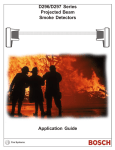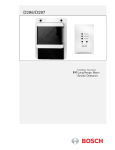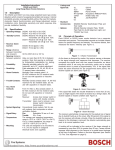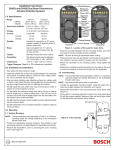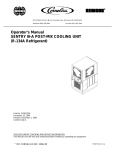Download Bosch DS484Q Specifications
Transcript
DS484Q/DS486Q Installation Instructions EN Quad Beam Photoelectric Detectors DS484Q/DS486Q | Installation Instructions | 1.0 Overview 1.0 Overview 1.1 Description The DS484Q and DS486Q are photoelectric quad beam detectors that use four pulsed infrared beams to activate an alarm relay upon detection of an intruder. Both models contain a transmitter that emits an invisible infrared beam, and a receiver. If the beam is broken, the receiver signals an alarm. Multiple channel operation provides increased system flexibility by allowing multiple devices to be used near each other without cross-talk or other interference. 1.2 Components Figure 1: DS484Q/DS486Q Components 1 2 3 10 11 5 6 4 12 13 7 14 15 8 16 17 9 123456- Chassis Base Cover Mounting holes Vertical adjustment screw (upper) Terminal block (transmitter has five terminals, receiver has nine terminals) 7 - Wire entrance 8 - Vertical adjustment screw (lower) 2 9 - Base mounting screws 10 - Optical module (upper) 11 - Scope (upper) 12 - Horizontal adjustment screw (upper) 13 - Operation panel (refer to Figure 2 or Figure 3) 14 - Optical module (lower) 15 - Scope (lower) 16 - Horizontal adjustment screw (lower) 17 –Cover mounting screw Bosch Security Systems, Inc. | 7/05 | 4998138530F DS484Q/DS486Q | Installation Instructions | 1.0 Overview . Figure 2: DS486Q Transmitter Operation Panel Figure 3: DS486Q Receiver Operation Panel 1 3 ALIGNMENT IS COMPLETED WHEN ‘ ‘ IS OFF POWER ALARM 1 2 100 200 130 260 160 320 OUTDOOR 60 INDOOR 120 4 150 200 400 75 200 400 5 50 500 INTERRUPTION TIME (msec) 2 BEAM POWER CONTROL (m) SWITCH OFF ↔ ON No ITEM OFF ON 1 Group A B 2 SEE CHART 3 BELOW 4 NULL SW2 - 3 : CHANNEL M 1 2 3 SW2 OFF OFF ON ON SW3 OFF ON OFF ON 300 100 180 360 EDC LEVEL SWITCH OFF ↔ ON No ITEM OFF ON 1 Group A B 2 SEE CHART 3 BELOW 4 AND/OR AND OR 5 BYPASS OFF ON 6 SOUND OFF ON CHECK SW2 - 3 : CHANNEL 3 6 M 1 2 3 SW2 OFF OFF ON ON SW3 OFF ON OFF ON MODEL:DS486Q 1 - POWER LED 2 - Beam power control 3 - DIP switches 1.3 Features 1.3.1 100 Times Sensitivity Allowance ALIGNMENT CHECK TERMINALS 123456- INTERRUPTION TIME switch Alignment check terminals ALARM LED Level meter Environmental discrimination circuit (EDC) LED DIP switches Stable operation is maintained even if 99% of beam energy is cut by environmental disturbances such as rain, fog, or frost. 1.3.2 Beam Power Control Use this feature to select the appropriate beam intensity for the detection range. Controlling beam intensity minimizes the risk of reflection off nearby walls and cross detection with other detectors. 1.3.3 Beam Interruption Time Control Use this feature to change the beam interruption time to best fit the application. 1.3.4 Using Multiple Transmitter-and-Receiver Sets Up to four transmitter-and-receiver sets can be stacked. 1.3.5 Selectable Beams The beams in the DS484Q and DS486Q are configurable into eight different combinations (two groups by four channels). These combinations can eliminate false alarms that can occur from cross-talk when multiple beams are stacked, or when the transmitter and receiver are separated by a long distance. The diameter of the transmitted beam increases with increased distance between the transmitter and receiver. At distances that approach the maximum range, the beam might reach two or more receivers. Refer to Section 2.1.2 Beam Spread on page 5 for additional information. Bosch Security Systems, Inc. | 7/05 | 4998138530F 3 DS484Q/DS486Q | Installation Instructions | 1.0 1.3.6 Selectable AND/OR Gate The photoelectric intrusion detection system in the DS484Q and DS486Q provides alarm relay activation for different considerations. Use the DIP Switches to select the required protection: AND gate – All four beams must be blocked simultaneously to cause an alarm. This setting results in fewer false alarms caused by birds and other small animals. OR gate – Either the upper or lower pairs of beams must be blocked. This setting can detect an intruder crawling on the ground. 1.3.7 Environmental Discrimination Circuit (EDC) The Environmental Discrimination Circuit (EDC) sends a signal when maintaining stable operation becomes difficult due to environmental disturbances. The EDC detects the gradual loss of signal along the beam’s path because of dirt built up on the cover, or because of rain, fog, or snow. If the signal decreases by 95% over at least 4-seconds, the EDC activates the EDC LED (refer to Figure 3 on page 3) and relay. This indicates that something is partially blocking a beam, or that the covers need cleaning. Overview Table 1: EDC BYPASS Switch States Detector Status BYPASS Switch OFF BYPASS Switch ON Poor Environmental Condition* EDC LED lights and EDC signal is provided through the normally-closed relay output at the receiver. EDC LED turns on and EDC signal is provided through the normally-closed relay output at the receiver. The alarm is generated by loss of beam energy. With the loss of beam energy, the ALARM LED lights but alarm signal is not generated (alarm relay is automatically shunted). EDC LED turns on and EDC signal is provided EDC LED turns on and EDC signal is provided. No alarm output is generated. If another optical module is blocked, the ALARM LED turns ON, but no alarm signal is generated. After the specified interruption time, the ALARM LED turns ON and alarm signal is generated. After the specified interruption time, the ALARM LED turns ON, and alarm signal is generated. If beams are blocked for more than 3 seconds, EDC LED turns ON, and EDC signal is generated. EDC LED does not turn ON, and EDC signal is not provided. When either optical module is blocked for 3 or more seconds. The EDC feature was not evaluated by Underwriters Laboratories (UL). Figure 4: Receiver DIP Switches When both optical modules are blocked for 3 seconds. 1 2 1 - DIP switches 1through 4 and 6 in the OFF position 2 - DIP Switch 5 (EDC BYPASS Switch) in the ON position To use the EDC Bypass Switch, set the receiver’s DIP Switch 5 to ON or OFF (Figure 4). Refer to Table 1 for information about the functions and detector status. ∗ Poor environmental condition refers to difficulty in maintaining stable operation due to environmental disturbances like fog or rain. Connect the EDC to a trouble circuit. Check the system after the EDC relay activates. 4 Bosch Security Systems, Inc. | 7/05 | 4998138530F DS484Q/DS486Q | Installation Instructions | 2.0 Installation . 2.1.1 2.0 Installation 2.1 Installation Considerations Read the following information before installing, wiring, and performing regular maintenance on the equipment. Do not install the detector: • near trees and plants where falling leaves can block the beam • where intense sources of light and sunlight can reflect directly into the receiver optics A beam of light shining at a ±3-degree angle of each receiver can cause false alarms. The beam strength is best if used within the maximum range of the detectors. If used for shorter distances, excess beam energy reaches the receiver resulting in reflection off nearby walls and incorrect communication with other detectors. 2.1.2 Figure 5: Beam Spread The beam spread is +0.7°. Refer to Figure 5 and Table 2 to determine the installation conditions. Table 2: Beam Spread Distances Between Transmitter and Receiver∗ m • • • • on movable surfaces where subject to splashing water or sea spray beyond the maximum range of each model where strong electrical noise or radio frequency interference occurs • where strong vibration occurs • in the presence of corrosive or explosive gas Face upper and lower optical modules toward each other on the transmitter and the receiver. • Do not install or wire detectors during a thunderstorm. • Do not supply power until all wiring is completed. • Maintain power between 10.5 VDC and 28 VDC at all times. • Do not disassemble or modify the base. Beam Strength over Distance ∗ Horizontal Spread∗ Total Vertical Spread∗ ft m ft m ft 20 66 0.5 1.7 0.8 2.6 40 131 1.0 3.3 1.3 4.3 60 197 1.5 4.9 1.8 5.9 80 263 2.0 6.6 2.2 7.2 100 328 2.5 8.2 2.7 8.9 120 394 3.0 9.8 3.2 10.5 140 459 3.5 11.5 3.7 12.1 160 525 4.0 13 4.2 13.7 180 591 4.5 14.8 4.7 15.4 200 656 6.0 16.4 5.2 17.1 Refer to Figure 5. Beam Spread 1 4 2 1 - Beam spread 2 - Distance between transmitter and receiver Bosch Security Systems, Inc. | 7/05 | 4998138530F 3 3 - Horizontal spread 4 - Total vertical spread 5 DS484Q/DS486Q | Installation Instructions | 2.0 2.2 Mounting Installation Figure 7: Mount the DS484Q and DS486Q in one of two ways: • Pole mounted • Wall mounted 2.2.1 Pole Mounting 1. Choose an appropriate mounting location for the system. Install poles with a clear line-ofsight between the transmitter and the receiver. 2. Loosen the transmitter’s cover mounting screw and remove the cover. Refer to Items 3 and 17 in Figure 1 on page 2. 3. Loosen the two mounting screws and remove the chassis by sliding it down against the base Refer to Refer to Items 1 and 9 in Figure 1 on page 2. Single Unit Pole Mounting 1. Use the short clamping screws to attach the mounting plates to the chassis. Refer to Figure 6. 2. If the pole diameter is between 3.8 cm and 4 cm (1.5 in. and 1.6 in.), use the shorter flange (1.0 cm [0.4 in.]) of the mounting plate. If the pole diameter is between 4 cm (1.6 in.) and 4.3 cm (1.7 in.), use the longer flange (1.5 cm [0.6 in.]) of the mounting plate. This ensures that the end of the screw does not contact the pole. Figure 6: 1 Using U-clamps 1 2 1 - U-clamp 2 - Long clamping screws 4. 5. 6. Insert the wiring through the chassis wire entrance, leaving enough wire to access the transmitter’s terminal block. Refer to Items 6 and 7 in Figure 1 on page 2. Slide the transmitter onto the chassis. Tighten the base mounting screws. Refer to Figure 1 on page 2. Repeat the mounting process for the receiver. Make sure to mount the receiver in direct line-ofsight of the transmitter. Using Mounting Plates 2 3 1 - Mounting plate 2 - Chassis 3 - Short clamping screws 3. 6 Use the U-clamps and the long clamping screws to attach the chassis firmly. Refer to Figure 7. Make sure the transmitter is mounted in direct line-ofsight of the receiver. Bosch Security Systems, Inc. | 7/05 | 4998138530F DS484Q/DS486Q | Installation Instructions | 2.0 . Back-to-Back Pole Mounting Figure 8: 3. Back-to-Back Pole Mounting Make sure that the units are aimed so that the transmitter and the receiver in the same set are aligned with each other. 2.2.2 1. 2. With spacers between the two units, mount the transmitter and the receiver back-to-back. Refer to Figure 8. Use nuts and bolts to attach each unit firmly to the pole. Figure 9: Installation Wall Mounting Refer to Figure 9 for Steps 1 through 7. 1. Loosen the transmitter’s cover mounting screw and remove the cover. 2. Loosen the two base mounting screws and remove the chassis by sliding it down against the base. 3. Insert wiring through the chassis wire entrance, leaving enough wire to access the transmitter’s terminal block. 4. Insert the chassis mounting screws through the mounting holes to mount the chassis on the mounting surface. 5. Insert wiring through the wire entrance of the transmitter. Remove the wire entrance at the bottom of the transmitter. 6. Reattach the transmitter to the chassis. 7. Repeat this mounting procedure for the receiver. Make sure it is mounted in a direct line-of-sight to the transmitter. Wall Mounting 1 3 2 5 4 6 8 7 1234- Chassis Base Cover Mounting holes Bosch Security Systems, Inc. | 7/05 | 4998138530F 5678- Terminal block Wire entrance Base mounting screws Cover mounting screw 7 DS484Q/DS486Q | Installation Instructions | 3.0 Wiring Figure 10: Transmitter, Terminal Block Wiring 3.0 Wiring + Apply power only after all connections are made and inspected. 1 COM Install these detectors according to the National Electrical Code, NFPA-70. 2 NC Table 7 is based on one set (transmitter and receiver) connected to the same wire run from the power source. 3 When installing two or more sets on one wire run, calculate the maximum length by dividing the maximum listed wire length by the number of sets installed. 1 - Power (non-polarized), 10.5 VDC to 28.0 VDC 2 - Tamper Output (1b), 30 VDC 0.1 A 3 - Synchronized wiring Connect the transmitters and receivers to a UL Listed power supply or control panel capable of providing standby power for at least 4 hours. Figure 11: Receiver, Terminal Block Wiring Test this system at least once a week to ensure proper operation. Table 3: Wire Gauge 2 [mm (AWG)] + 1 - Wire Length / AWG Chart COM Maximum Distance [m (ft)] DS484Q DS486Q NC 12 VDC 24VDC 12VDC 24VDC 2 0.8 (22) 90 (295) 850 (2789) 80 (295) 730 (2395) NO 1.06 (19) 180 (591) 1670 (5479) 150 (492) 1420 (4659) EDC 1.37 (17) 330 (1083) 3020 (9908) 280 (919) 2580 (8465) 1.8 (14) 590 (1936) 5370 (17618) 500 (1640) 4570 (14993) 3 NC TAMPER 4 NC 1234- 8 Power (non-polarized), 10.5 VDC to 28.0 VDC Alarm Output (1c), 30 VDC 0.2 A EDC Output (1b), 30 VDC 0.2 A Tamper Output (1b), 30 VDC 0.1 A Bosch Security Systems, Inc. | 7/05 | 4998138530F DS484Q/DS486Q | Installation Instructions | 3.0 Wiring . Figure 12: Single Set - Wiring Example 4 5 + + - - 1 COM NC 2 3 4 - Power output 5 - Alarm input (INC) 1 - Terminal block on transmitter and receiver 2 - Receiver 3 - Transmitter Figure 13: Two Sets on the Run – Wiring Example 4 5 1 + + + + - - - - COM COM NC NC 2 1 - Terminal block on transmitter and receiver 2 - Receiver 3 - Transmitter Bosch Security Systems, Inc. | 7/05 | 4998138530F 3 2 3 4 - Power output 5 - Alarm input (INC) 9 DS484Q/DS486Q | Installation Instructions | 4.0 3. 4.0 Setup and Alignment 4.1 Setup 4.1.1 Receiver Setup Setup and Alignment Figure 14: Receiver Setup Switches ALIGNMENT IS COMPLETED WHEN ‘ ‘ IS OFF ALARM 1 150 200 300 100 400 75 Choose whether or not to bypass alarms by setting DIP Switch 5 to ON or OFF when the EDC activates. Refer to Section 1.3.7 Environmental Discrimination Circuit (EDC) on page 4 for more information. The EDC is always on. DIP Switch 5 (BYPASS) controls the alarm condition relative to the EDC relay status. Refer to Figure 4 on page 4. • If DIP Switch 5 is ON, the system alarms only if the EDC relay is not activated. If the EDC is activated, the system does not indicate an alarm. • If DIP Switch 5 is OFF, the system alarms regardless of whether the EDC relay is activated or not. 50 500 INTERRUPTION TIME (msec) Connect the EDC to a trouble circuit, and check the system any time the EDC relay activates. EDC LEVEL SWITCH OFF ↔ ON No ITEM OFF ON 1 Group A B 2 SEE CHART 3 BELOW 4 AND/OR AND OR 5 BYPASS OFF ON 6 SOUND OFF ON CHECK SW2 - 3 : CHANNEL 2 If the EDC remains activated for prolonged periods when the beam path is clear, the beam might be misaligned. Refer to Section 4.2 Alignment on page 13 to realign the beam. 3 M 1 2 3 SW2 OFF OFF ON ON SW3 OFF ON OFF ON ALIGNMENT CHECK TERMINALS 4. 1 - INTERRUPTION TIME switch 2 - DIP Switch 4 (ON or OFF for the AND/OR gate) 3 - DIP Switch 5 2. Select the beam alarm condition by setting DIP Switch 4 ON or OFF for the AND/OR gate. Refer to Figure 14. • If DIP Switch 4 is ON, the OR condition is selected. The upper or lower beam pairs must be broken to cause an alarm. • If DIP Switch 4 is OFF, the AND condition is selected. The upper and lower beam pairs must be broken to cause an alarm. Use a Phillips head screwdriver to adjust the rotary INTERRUPTION TIME switch according to how sensitive you want the detector to be to movement (catch performance). Refer to Figure 14 for the location of the INTERRUPTION TIME switch. Refer to Table 4 for interruption times and corresponding catch performance examples. For UL applications, the interrupt time cannot be set above 75 ms. For best performance when using the AND mode, do not exceed 100 ms beam interruption time. Table 4: Beam Interruption Time Examples Interrupt Time (ms) 50 100 Running Jogging 200 300 Fast Walking 400 500 10 Catch Performance Normal Walking Slow Moving Bosch Security Systems, Inc. | 7/05 | 4998138530F DS484Q/DS486Q | Installation Instructions | 4.0 . 4.1.2 Transmitter Setup Table 6: Setup and Alignment Settings for Indoor Beam Power Control Figure 15: Transmitter Setup Switches DS484Q POWER 100 200 130 260 160 320 OUTDOOR 60 INDOOR 120 180 360 Volume Setting Range m (ft) 80 0 to 80 (0 to 263) 40 to 120 (263 to 394) 120 to 160 (394 to 525) 160 to 200 (525 to 656) 200 to 220 (656 to 722) 220 to 240 (722 to 787) 120 0 to 120 (0 to 394) 120 to 200 (394 to 656) 200 to 260 (656 to 853) 260 to 320 (853 to 1050) 320 to 360 (1050 to 1181) 360 to 400 (1181 to 1312) 160 200 400 200 BEAM POWER CONTROL (m) SWITCH OFF ↔ ON No ITEM OFF ON 1 Group A B 2 SEE CHART 3 BELOW 4 NULL SW2 - 3 : CHANNEL M 1 2 3 SW2 OFF OFF ON ON SW3 OFF ON OFF ON 220 2 240 4.1.3 200 260 320 360 400 Beam Group and Channel Setup When installing only one transmitter and one receiver (a set), beam group and channel selection is not required. Leave the switches on the transmitter and receiver in the original (OFF) positions. Refer to Figure 17 on page 12. MODEL:DS486Q 1 - Beam Power Control rotary switch 2 - DIP Switches 1, 2, and 3 Turn the Beam Power Control rotary switch to the volume setting for the appropriate detection range. Refer to Figure 15, Table 5 and Table 6. Table 5: Range m (ft) 120 1 DS486Q Volume Setting Settings for Outdoor Beam Power Control The transmitter and the receiver have eight selectable beams. The beams are divided into two groups (Group A and Group B) of four beams each. The beams are referred to as channels (Channels M, 1, 2, and 3). Refer to Figure 16. Figure 16: Beam Group and Channel Organization DS484Q DS486Q Volume Setting Range m (ft) Volume Setting Range m (ft) 40 0 to 40 (0 to 131) 40 to 60 (131 to 197) 60 to 80 (197 to 263) 80 to 100 (263 to 328) 100 to 110 (328 to 361) 110 to 120 (361 to 394) 60 0 to 60 (0 to 197) 60 to 100 (197 to 328) 100 to 130 (328 to 427) 130 to 160 (427 to 525) 160 to 180 (525 to 591) 180 to 200 (591 to 656) 60 80 100 110 120 100 130 160 180 200 Bosch Security Systems, Inc. | 7/05 | 4998138530F BEAM GROUP A GROUP B CHANNEL M CHANNEL 1 CHANNEL 2 CHANNEL 3 CHANNEL M CHANNEL 1 CHANNEL 2 CHANNEL 3 Channels 1, 2 or 3 can emit beams only when Channel M in the same group provides those channels with synchronized (synchro) wiring. Refer to Section 4.1.4 Synchronized Wiring on page 12. When installing two or more sets in the same group, set only the first set to Channel M. Set the remaining sets to Channel 1, 2, or 3. 11 DS484Q/DS486Q | Installation Instructions | 4.0 Figure 17: Transmitter and Receiver DIP Switch Settings – One Set 1 Setup and Alignment Table 7: 2 3 Group Selection DIP Switch 1 Group OFF ON A B Table 8: Channel Selection DIP Switch 1 - Transmitter DIP Switches with original settings (Group A, Channel M) 2 - Receiver DIP Switches with original settings (Group A, Channel M) 2 - DIP Switches 1, 2, and 3 4.1.4 1 - Transmitter DIP Switches set for Group B, Channel 3 2 - Receiver DIP Switches set for Group B, Channel 3 2 - DIP Switches 1, 2, and 3 Set DIP Switches 1, 2 and 3 to OFF or ON on each transmitter and receiver, according to the desired group and channel selections. Refer to Table 7 and Table 8 for the DIP Switches 1, 2, and 3, and the example for Group B, Channel 2 in Figure 18. Channel M 1 ON ON OFF ON 2 3 When installing two or more sets, use different settings for each set (transmitter and receiver) to avoid incorrect communication. 2 3 3 OFF ON One transmitter and one receiver facing each other are a set. In a set, each unit must have the same setting for group and for channel. Figure 18: Example of Transmitter and Receiver DIP Switch Settings – Two or More Sets 1 2 OFF OFF Synchronized Wiring Synchronized (abbreviated “synchro”) wires are required when installing two or more sets in the same group by using the SYNCHRO terminal on each transmitter. Synchro wires are not required between the receivers. The synchro wire should be more than 0.8 mm (22 AWG) in diameter, run no longer than 20 m (66 ft), and be wired only to the same group (Group A to Group A or Group B to Group B). Do not wire across groups (Group A to Group B). Synchronized transmitters must use a common power supply. The system does not activate when synchro wires are connected improperly, or if other unneeded wires are connected. The POWER LED flashes when the required wires are not connected correctly. When the POWER LED flashes, shut off the power and reconnect the wires correctly. 12 Bosch Security Systems, Inc. | 7/05 | 4998138530F DS484Q/DS486Q | Installation Instructions | 4.0 Setup and Alignment . 4.2 Alignment 4.2.1 Description Precise, correct alignment is critical for these systems to operate effectively. The first procedure (Section 4.2.2 Scope Alignment on page 14) is a visual alignment and is not precise. Use one of the additional procedures to complete the alignment. Table 9: Fine Alignment Considerations Alignment Procedure Considerations Voltmeter (Refer to Section 4.2.3 Voltmeter Alignment on page 15.) • Requires a voltmeter and a In the coarse alignment, if the installed devices do not face each other directly, the upper optical module and the lower optical module on each device are manually turned toward the opposite device. Then the opposite device is viewed through the scopes on the upper and lower optical modules while the horizontal and vertical angles are adjusted, using the turntable and the adjustment screws. Refer to Section 4.2.2 Scope Alignment on page 14. Fine Alignment The detectors have three possible fine alignment methods: Voltmeter, Level LED, and Sound. Alignment interruption sheets (Figure 19) are used in all three procedures to cover all optical modules in the installation except the pair that are being aligned. Select a procedure based on the conditions and considerations of the specific installation. Refer to Table 9. • Works well at any distance between the transmitter and receiver • Requires repeated observation of the voltmeter at the receiver Aligning a paired transmitter and receiver requires a coarse, or visual, alignment followed by a fine alignment. Coarse Alignment screwdriver Level LED (Refer to Section 4.2.4 Level LED Alignment on page 15.) • • • • Most accurate Might require two people Requires only a screwdriver More difficult to do when the transmitter and receiver are installed far apart • Requires repeated visual observation of the level meter on the receiver Sound (Refer to Section 4.2.5 Sound Alignment on page 15.) • Might require two people • Requires only a screwdriver • Works well at any distance between the transmitter and receiver • Does not require visual observation of the opposite device • Difficult to do in a noisy environment Figure 19: Alignment Interruption Sheet Bosch Security Systems, Inc. | 7/05 | 4998138530F 13 DS484Q/DS486Q | Installation Instructions | 4.0 Setup and Alignment 4.2.2 Scope Alignment 1. Apply power to all transmitters and receivers in the installation. 2. Select a transmitter and receiver pair to align. 3. For coarse tuning, rotate the turntable on the upper or lower optical module of the transmitter horizontally to face the receiver. 4. Look into the left or right viewfinder of the optical module to see the image reflected through the scope aperture. Stand at a 45° angle and at eye level to the left or right viewfinder, at a distance of 10 cm to 15 cm (4 in. to 6 in.) away. Refer to Figure 20. Figure 21: Optical Module 2 5 3 6 Interruption S heet Figure 20: Using the Optical Module Scope 7 1 2 4 1 12345- Interruption sheet Optical module Punched holes Scope apertures Viewfinder 8 9 6 - Alignment scope 7 - Turntable 8 - Vertical adjustment screw 9 - Horizontal adjustment screw 3 Figure 22: Viewed Image 1 4 2 5 1 - Top view optical module of transmitter or receiver 2 - Left viewfinder 3 - Right viewfinder 4 - Viewing distance (10 cm to 15 cm [4 in. to 6 in.]) 5 - Viewing angle (approximately 45° from centerline of optical module) 5. Use the turntable to adjust the horizontal angle of the optical module until the receiver image appears in the viewfinder. Refer to Figure 21 and Figure 22. 6. Use the horizontal and vertical adjustment screws to center the receiver image in the outline of the scope aperture. Refer to Figure 21 and Figure 22. 7. Repeat Steps 3 through 6 for the other optical module on the transmitter. 8. Do Steps 3 through 6 for the optical modules on the receiver to align the transmitter image. 14 1 - Scope aperture 2 - Receiver image 9. Use the supplied alignment interruption sheets to cover the upper and lower optical modules of all transmitters and receivers to be aligned. When covering an optical module, align the punched holes in the interruption sheet with the scope apertures in the center of the optical module (Figure 21). Bosch Security Systems, Inc. | 7/05 | 4998138530F DS484Q/DS486Q | Installation Instructions | 4.0 Setup and Alignment . For synchronized applications or stacked sets of transmitters and receivers, install interruption sheets on all optical modules except the pair to be aligned. 10. Do one of the fine alignments. Refer to Table 9 on page 13 to determine which procedure to use. For the following procedures, make sure that all optical modules are covered with interruption sheets, except the pair to be aligned. Remove the interruption sheets and close the covers when the alignment is complete. 4.2.3 Voltmeter Alignment 1. Insert voltmeter leads into the alignment check terminals on the receiver panel. Refer to Figure 3 on page 3 2. Set the voltmeter scale to 10.0 VDC. 3. Use a screwdriver to adjust horizontal and vertical adjustment screws on the transmitter and the receiver. Refer to Figure 21 on page 14. 4. Check the voltage reading and continue to adjust the adjustment screws as necessary. In an ideal environment, the voltmeter value should be 3.0 VDC or higher. (The maximum voltage is 3.75 VDC.) 5. When the best voltage is achieved, the optical modules are aligned. 6. Repeat the procedure for the other optical module pair. 4.2.4 Level LED Alignment 1. Look at the Level Meter on the receiver. Refer to Figure 23. When you begin this procedure the LEDs are off. 2. Use a screwdriver to adjust the optical modules. Adjust the horizontal and vertical adjustment screws as necessary. Refer to Figure 21. 3. As more beam energy is received, each LED turns on, flashes quickly, flashes slowly, and then turns off. 4. Continue fine tuning until the LEDs turn off. • If outdoors, the alignment is complete when all LEDs are off. • If indoors, the alignment is complete when the lower two LEDs are off. 5. Repeat the procedure for the other optical module pair. Bosch Security Systems, Inc. | 7/05 | 4998138530F 4.2.5 Sound Alignment 1. Set DIP Switch 6 on the receiver to ON. Refer to Figure 23. 2. Use a screwdriver to adjust the optical modules. Adjust the horizontal and vertical adjustment screws as necessary. Refer to Figure 21. 3. As more beam energy is received, the sound pitch changes from low to high and from a continuous tone to a two beat sound. 4. Continue fine tuning until the buzzer is a two-beat sound. 5. After the beams are aligned, set DIP Switch 6 to OFF. 6. Repeat the procedure for the other optical module pair. Figure 23: Receiver Operation Panel 1 2 ALIGNMENT IS COMPLETED WHEN ‘ ‘ IS OFF ALARM 3 150 200 300 100 400 75 50 500 INTERRUPTION TIME (msec) EDC LEVEL SWITCH OFF ↔ ON No ITEM OFF ON 1 Group A B 2 SEE CHART 3 BELOW 4 AND/OR AND OR 5 BYPASS OFF ON 6 SOUND OFF ON CHECK SW2 - 3 : CHANNEL 5 M 1 2 3 SW2 OFF OFF ON ON SW3 OFF ON OFF ON 4 ALIGNMENT CHECK TERMINALS 12345- Outdoor level alignment guide Indoor level alignment guide Level meter Alignment check terminals DIP switch 6 in the ON position 15 DS484Q/DS486Q | Installation Instructions | 5.0 Walk Test 5.0 Walk Test Walk across the beam path directly in front of one of the detectors. The ALARM LED should activate. If not, the beam interrupt time is set too low or the alignment is not correct. Walk across the beam path in several locations between the detectors (Figure 24).Each time you cross the beam path, the ALARM LED should activate. If not, the beam interrupt time is set too low or the alignment is not correct. Figure 24: Walk Test Pattern 3 1 2 4 1 - Receiver 2 - Transmitter 3 - Beam path 4 - Crossing the beam path Inspect the system and perform a walk test at least once a year. 16 Bosch Security Systems, Inc. | 7/05 | 4998138530F DS484Q/DS486Q | Installation Instructions | 6.0 Stacking Information . 6.0 Stacking Information When stacking two or more sets, use the group and channel settings shown in Figure 25. The correct DIP switch settings are shown for each transmitter and receiver. Figure 25: Examples of Stacking Multiple Transmitter and Receiver Sets 1 2 3 1 2 1 4 M 5 1 2 3 1 - Receiver 2 - Transmitter 3 - Synchronized wiring 4- Receiver DIP switches 5 - Transmitter DIP switches Each top line set must be set to Channel M, and the other line sets to Channels 1, 2, or 3 to avoid incorrect communication between the stacking sets. Bosch Security Systems, Inc. | 7/05 | 4998138530F 17 DS484Q/DS486Q | Installation Instructions | 7.0 7.0 Troubleshooting Troubleshooting If the system does not operate as expected, check for the following conditions. The input voltage is between 10.5 VDC and 28 VDC at the terminal on the transmitter and on the receiver. The loop resistance of the alarm output is less than 100 Ω. The monitor LED on the transmitter is ON. The ALARM LED on the receiver is ON when both upper and lower beams are simultaneously adjusted for the beam interruption time. The output of the beam alignment check terminal on the receiver is 3.0 VDC to 3.75 VDC. Table 10: Common Troubleshooting Problems and Solutions Problem Cause Solution Constant alarm output Something is blocking the beams. Remove the object(s). Optical modules or covers need cleaning. Clean the optical modules and the covers. Improper channel selection Select the proper channel. Refer to Section 4.1.3 Beam Group and Channel Setup on page 11. Synchronized wires are not connected. Connect the synchro wiring correctly. Refer to Section 4.1.4 Synchronized Wiring on page 12. Frequent false alarms No alarm when beams are blocked EDC LED turns ON frequently Something is blocking the beams. Remove the object(s). Beam interruption time is set too short. Decrease the sensitivity. Refer to Section 4.1.1 Receiver Setup on page 10. Electrical noise or radio frequency interferency (RFI) nearby Change the installation site. Wiring too close to power sources or power line Change the routing of the wiring. Unstable installation site Fix the installation site. Out of maximum protection range Reinstall the units within the maximum protection range. Refer to Section 2.1 Installation Considerations on page 5. Inappropriate Beam Power Control level Readjust the control level. Refer to Table 5 and Table 6 in Section 4.2 Alignment on page 13. Frost or dew is present. Attach the optical heater. Beams are reflected into the receiver. Remove the reflective object or change the installation site. Beam interruption time is set too slow. Increase the sensitivity. Refer to Section 4.1.1 Receiver Setup on page 10. Not enough beam power Increase the beam power. Refer to Table 5 and Table 6 in Section 4.2 Alignment on page 13. Something is blocking the beams. Installed on unstable ground Out of maximum protection range Remove the object(s). Fix the installation site. Reinstall the units within the maximum protection range. Refer to Section 2.1 Installation Considerations on page 5. Readjust the control level. Refer to Table 5 and Table 6 in Section 4.2 Alignment on page 13. Inappropriate Beam Power Control level POWER LED on transmitter flickers 18 Frost or dew is present. Synchro wires are not connected. Attach the optical heater. Connect the synchro wiring correctly. Refer to Section 4.1.4 Synchronized Wiring on page 12. Bosch Security Systems, Inc. | 7/05 | 4998138530F DS484Q/DS486Q | Installation Instructions | 8.0 Specifications . 8.0 Specifications Table 11: DS484Q and DS486Q Specifications Alarm Output Alarm Form C 0.2 A @ 30 VDC Output Period: 3 sec EDC NC 0.2 A @ 30 VDC Output Period: 3 sec Tamper NC 0.1 A @ 30 VDC Output Period: While the cover is removed Beam Interrupt Time Adjustable from 50 ms to 500 ms Selectable Beams Two Groups by four Channels Environmental Discrimination Circuit Output Normally-closed contacts rated at 0.2 A @ 30 VDC DS484Q 120 m (400 ft) Maximum Coverage Outdoor DS486Q Indoor 200 m (660 ft) DS484Q 240 m (800 ft) DS486Q 300 m (1000 ft) Enclosure Design Material Polycarbonate Dimensions (HxWxD) Receiver 35 cm x 10 cm x 11 cm (13.75 in. x 4 in. x 4.1 in.) 1.2 kg (2.64 lb) Transmitter 1.2 kg (2.64 lb) Total Weight Environmental Considerations Operating Temperature -25° C to + 55° C (-13°F to + 130° F) IP Rating IP 54 (protection against dust; protection against splashing water) Mounting Location Surface or pole mount Pattern Pointability ±90° horizontal, ±10° vertical Power Requirements Voltage Current Draw 10.5 VDC to 28 VDC non-polarized Receiver 80 mA standby, 50 mA alarm Transmitter DS484Q 35 mA DS486Q 55 mA Backup Power Requirements 4 hours (120 mAh) minimum required for UL Certificated Installations Temper Output Trigger Response Time Normally-closed contacts rated at 0.1 A @ 30 VDC Selectable response time of 35 ms to 700 ms Bosch Security Systems, Inc. | 7/05 | 4998138530F 19 Bosch Security Systems, Inc. 130 Perinton Parkway Fairport, NY 14450-9199 Customer Service: (800) 289-0096 Technical Support: (888) 886-6189 © 2005 Bosch Security Systems 4998138530F





















